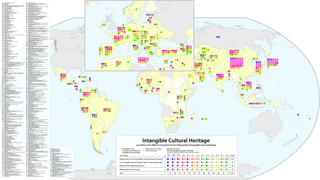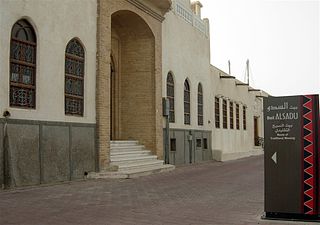Al Sadu in Kuwait
There are two main settings for Al Sadu in Kuwait: the desert, the traditional home of the nomadic Bedouin, where weaving was carried out by women; and the settled, urban existence of the town, where a very different type of weaving was undertaken by men. The history of wool weaving in the Arabian desert goes back thousands of years with woven items such as the tent and its colorful dividers, storage bags and animal trappings. In the urban setting of the town, men took on the weaving of cloth for the bisht (a man's cloak). [3]
The Al Sadu Society of Kuwait is dedicated to preserving, documenting and promoting the rich and diverse textile heritage of the Kuwaiti Bedouin, from the nomadic weaving of the desert through to the urban weaving of the town. Begun in 1978, as a private initiative, by a group of concerned Kuwaitis who wished to preserve a fast disappearing, yet intrinsic, cultural identity, the Al Sadu Project was founded. In 1991, soon after the Liberation of Kuwait, the project was transformed into Al Sadu Weaving Co-operative Society, a venture owned and run by the weavers and artisans themselves. The society runs a gallery, museum, shop and workshop at Sadu House (Beit al Sadu). [4]
In 2020 at the Session of the UNESCO Intergovernmental Committee for the Safeguarding of the Intangible Cultural Heritage, Al Sadu in the Kuwait was inscribed on the List of Intangible Cultural Heritage in Need of Urgent Safeguarding. [1]
Al Sadu in the United Arab Emirates
Al Sadu in the United Arab Emirates is a traditional form of weaving practised by Bedouin women in rural communities. Traditionally men shear goats and camels, and the wool is cleaned and prepared by the women. The yarn is spun on a drop spindle, then dyed using local plant extracts (such as henna or saffron), and then woven on a floor loom using a warp-faced plain weave. The traditional colours are black, white, brown, beige and red, with distinctive patterns in the form of narrow bands of geometric designs. The result is colourful products: clothing, camel and horse decorations, Bedouin tents, majlis floor pillows, carpets and mats. Traditionally, women gather in small groups to spin and weave, exchanging family news and occasionally chanting and reciting poetry. Such gatherings are also the means of transmitting the tradition: girls learn by watching, and are gradually given tasks to do, such as sorting the wool, before learning the more intricate skills involved. [5]
In 2011 at the Sixth Session of the UNESCO Intergovernmental Committee for the Safeguarding of the Intangible Cultural Heritage, Al Sadu in the United Arab Emirates was inscribed on the List of Intangible Cultural Heritage in Need of Urgent Safeguarding. [6]
Al Sadu in Qatar
Sadu weaving in Qatar like their neighbouring countries is an ancient form of weaving practiced by nomadic women. Traditionally, nomadic people obtained most of the raw materials from their flocks: fibres were made of sheep wool or camel or goat hair. The short fibres were combed and teased, before spinning them to create a continuous yarn. Women of all ages could often be found spinning throughout the day, as they carried out other daily activities, such as herding, or cooking. [7] Al-Sadu weaving is distinguished by its technique, in which long and narrow strips of cloth, sometimes up to 7 metres, are woven individually on a horizontal ground loom. [8] The bands are then sewn together to create a large canvas. It was common for these designs to reflect the desert environment. Symbols represented the stars, meteorological phenomena, or sand dunes, desert plants or animals. Weavers also depicted the jewellery and face decorations that women of the tribe wore to represent not only their beauty, but also the tribe’s wealth. [9]
In 2021, Embrace Doha an independent cultural house located in Souq Al Wakrah curated two private galleries dedicated to telling the story of Sadu from the prospective of the last few local Sadu weavers left in the country. The aim of their work is to bring attention to the urgency of safeguarding the intangible heritage of Sadu weaving to ensure the continuity and preservation efforts for the wider community.

The Bedouin, Beduin, or Bedu are pastorally nomadic Arab tribes who have historically inhabited the desert regions in the Arabian Peninsula, North Africa, the Levant, and Mesopotamia. The Bedouin originated in the Syrian Desert and Arabian Desert but spread across the rest of the Arab world in West Asia and North Africa after the spread of Islam. The English word bedouin comes from the Arabic badawī, which means "desert dweller", and is traditionally contrasted with ḥāḍir, the term for sedentary people. Bedouin territory stretches from the vast deserts of North Africa to the rocky ones of the Middle East. They are sometimes traditionally divided into tribes, or clans, and historically share a common culture of herding camels, sheep and goats. The vast majority of Bedouins adhere to Islam, although there are some fewer numbers of Christian Bedouins present in the Fertile Crescent.
Ikat is a dyeing technique from Indonesia used to pattern textiles that employs resist dyeing on the yarns prior to dyeing and weaving the fabric. The term is also used to refer to related and unrelated traditions in other cultures. In Southeast Asia, where it is the most widespread, ikat weaving traditions can be divided into two general clades. The first is found among Daic-speaking peoples. The second, larger group is found among the Austronesian peoples and spread via the Austronesian expansion. Similar dyeing and weaving techniques that developed independently are also present in other regions of the world, including India, Central Asia, Japan, Africa, and the Americas.

Kochari is a folk dance originating in the Armenian Highlands. It is performed today by Armenians, while variants are performed by Assyrians, Azerbaijanis, Kurds, and Pontic Greeks. It is a form of circle dance.

A Persian carpet or Persian rug, also known as Iranian carpet, is a heavy textile made for a wide variety of utilitarian and symbolic purposes and produced in Iran, for home use, local sale, and export. Carpet weaving is an essential part of Persian culture and Iranian art. Within the group of Oriental rugs produced by the countries of the "rug belt", the Persian carpet stands out by the variety and elaborateness of its manifold designs.
An oriental rug is a heavy textile made for a wide variety of utilitarian and symbolic purposes and produced in "Oriental countries" for home use, local sale, and export.

Piña is a traditional Philippine fiber made from the leaves of the pineapple plant. Pineapples are indigenous to South America but have been widely cultivated in the Philippines since the 17th century, and used for weaving lustrous lace-like luxury textiles known as nipis fabric. The name is derived from Spanish piña, meaning "pineapple".

Palestinian traditional clothing are the types of clothing historically and sometimes still presently worn by Palestinians. Foreign travelers to Palestine in the 19th and early 20th centuries often commented on the rich variety of the costumes worn, particularly by the fellaheen or village women. Many of the handcrafted garments were richly embroidered and the creation and maintenance of these items played a significant role in the lives of the region's women.

Azerbaijani carpet is a traditional carpet (rug) made in Azerbaijan. The Azerbaijani carpet is a handmade textile of various sizes, with a dense texture and a pile or pile-less surface, whose patterns are characteristic of Azerbaijan's many carpet-making regions. Traditionally, the carpets were used in Azerbaijan to cover floors, decorate interior walls, sofas, chairs, beds and tables.

A Turkmen rug is a type of handmade floor-covering textile traditionally originating in Central Asia. It is useful to distinguish between the original Turkmen tribal rugs and the rugs produced in large numbers for export mainly in Pakistan and Iran today. The original Turkmen rugs were produced by the Turkmen tribes who are the main ethnic group in Turkmenistan and are also found in Afghanistan and Iran. They are used for various purposes, including tent rugs, door hangings and bags of various sizes.

UNESCO established its Lists of Intangible Cultural Heritage with the aim of ensuring better protection of important intangible cultural heritages worldwide and the awareness of their significance. This list is published by the Intergovernmental Committee for the Safeguarding of Intangible Cultural Heritage, the members of which are elected by State Parties meeting in a General Assembly. Through a compendium of the different oral and intangible treasures of humankind worldwide, the programme aims to draw attention to the importance of safeguarding intangible heritage, which UNESCO has identified as an essential component and as a repository of cultural diversity and of creative expression.
Saudi Arabian art is contextual to the country being the birthplace of Islam; it includes both the arts of Bedouin nomads and those of the sedentary peoples of regions such as the Hejaz, Tihamah, Asir and Najd.

Sadu House is an artistic house and museum in Kuwait City, Kuwait, located near the Kuwait National Museum.

Azerbaijani carpet weaving is a historical and traditional activity of the Azerbaijani people. The Azerbaijani carpet is a traditional handmade textile of various sizes, with dense texture and a pile or pile-less surface, whose patterns are characteristic of Azerbaijan's many carpet-making regions. Carpet making is a family tradition transferred orally and through practice.
Yūki-tsumugi (結城紬) is a variety of silk cloth produced in Japan, chiefly in Yūki in Ibaraki Prefecture. It is designated as one of the Important Intangible Cultural Properties of Japan, and has also been inscribed on the UNESCO Representative List of the Intangible Cultural Heritage of Humanity.

Noken is a traditional Papuan multifunctional knotted or woven bag native to the Western New Guinea region, Indonesia. Its distinctive usage, which involves being hung from the head, is traditionally used to carry various goods, and also children.
Intangible cultural heritage (ICH) includes traditions and living expressions that are passed down from generation to generation within a particular community.

The Tan-Tan Moussem is an annual gathering held since 1963 by more than thirty tribes from southern Morocco and other parts of Northwest Africa in Tan-Tan, a town in south-western Morocco. In traditional Berber culture, a moussem is "a type of annual fair with economic, cultural and social functions."
Sheikha Bibi Duaij Al-Jaber Al-Sabah is a migration rights activist and curator from Kuwait. She founded the Social Work Society, which campaigns for the rights of migrant workers, and chairs Sadu House, a textiles museum and cultural centre dedicated to the woven art of Al Sadu.











